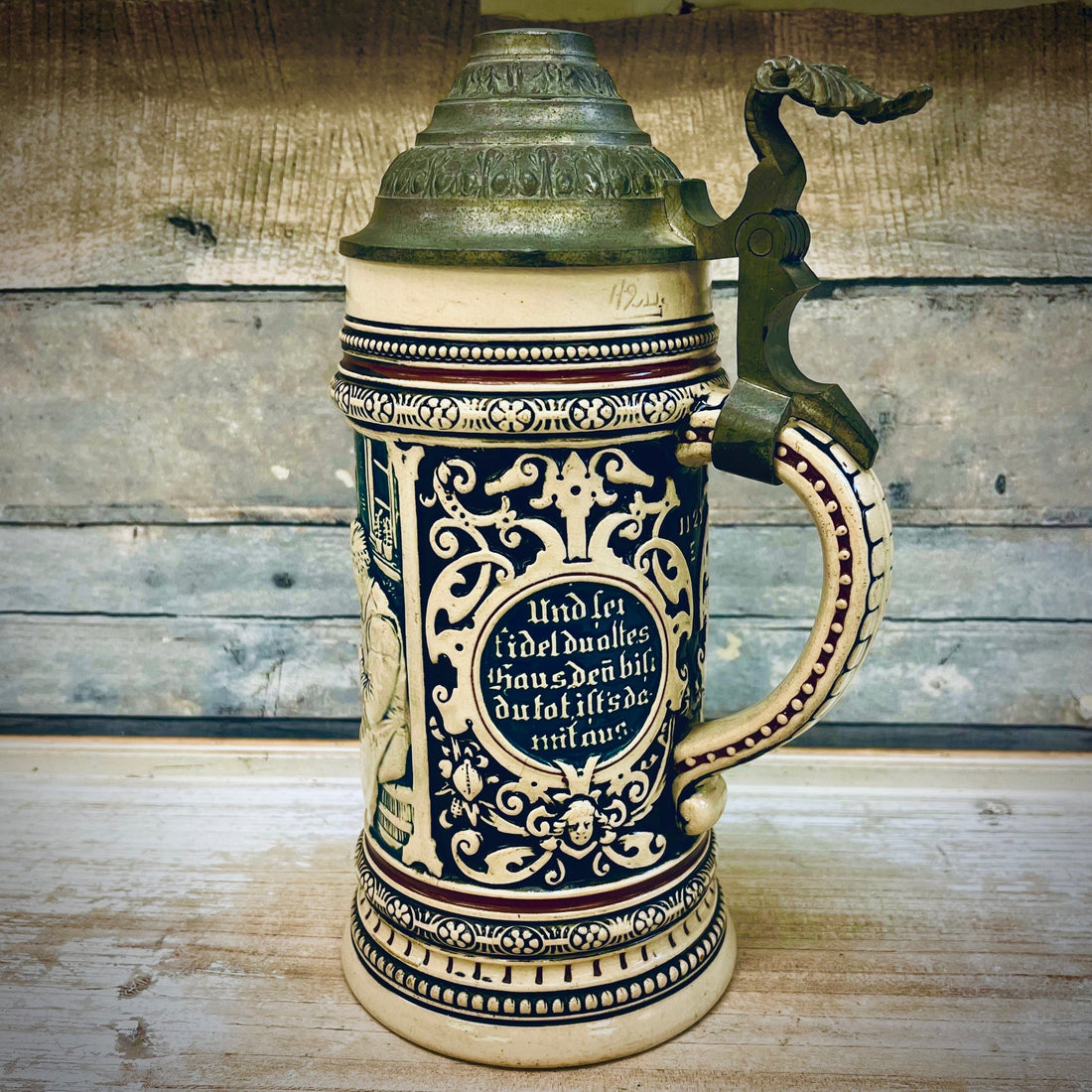
A Collector’s Guide to Antique German Beer Steins
Share
For centuries, beer steins have been an iconic part of German drinking culture. These ornately decorated mugs are more than just vessels for beer—they are pieces of history, craftsmanship, and tradition. Among collectors, antique German beer steins are highly sought after, particularly those made by renowned manufacturers such as Thewalt, Merkelbach & Wick, and Reinhold Merkelbach. Let’s take a journey through the history of beer steins and explore some of the most respected makers of these treasured artifacts.
A Brief History of German Beer Steins
The tradition of beer steins dates back to the 14th century in Germany, when concerns over hygiene led to the implementation of laws requiring all beverage containers to have lids. This was due in part to the bubonic plague and a desire to keep flies out of drinks. Early steins were often made of stoneware, pewter, or wood, with hinged pewter lids operated by a thumb lever for easy one-handed use.
During the 16th and 17th centuries, beer steins became more than just functional drinking vessels—they evolved into works of art. Artisans began adding elaborate designs, intricate carvings, and hand-painted decorations. By the 19th century, beer steins were produced in greater numbers, as Germany’s beer culture flourished.
Today, antique German beer steins remain prized collectibles, admired for their detailed craftsmanship, historical significance, and the rich stories they tell about German culture.
Notable German Beer Stein Makers
Several German manufacturers played a key role in shaping the industry. Below are three notable names that have left a lasting mark on beer stein production.
Founded in 1893, Thewalt was one of the oldest beer stein manufacturers in Germany. Known for producing high-quality stoneware steins, Thewalt pieces often feature traditional German motifs such as hunting scenes, medieval figures, and ornate relief work. Their steins were typically made from salt-glazed stoneware, giving them a distinctive textured appearance.
Although Thewalt ceased production in 2010, their legacy continues through limited-edition steins produced under the Thewalt 1893 brand, which still upholds the craftsmanship of the original company.
Established in the 1870s, Merkelbach & Wick was a key player in the production of high-quality stoneware beer steins. The company was particularly known for its innovative glazes and elegant Art Nouveau designs. Their steins often featured hand-painted decorations, relief carvings, and distinctive pewter lids.
Many Merkelbach & Wick steins were produced with a signature ivory-colored stoneware body, a hallmark of their craftsmanship. The company operated successfully for decades before ceasing production in the early 20th century.
Founded in 1882, Reinhold Merkelbach became known for producing some of the finest beer steins in Germany. Unlike some other manufacturers, Reinhold Merkelbach steins often featured a minimalist approach with a focus on high-quality materials and artistic design. Many of their pieces were heavily influenced by the Jugendstil (German Art Nouveau) movement, with sleek lines and artistic flair.
Collectors today prize Reinhold Merkelbach steins for their craftsmanship and distinctive aesthetic, which set them apart from more traditional beer steins of the era.
Collecting Antique Beer Steins
If you’re interested in collecting antique German beer steins, here are a few tips to keep in mind:
• Look for Manufacturer Marks: Many steins have markings on the bottom that indicate the maker, year, and sometimes even the artist. This can help authenticate a stein’s origin and value.
• Check for Hand-Painted vs. Printed Designs: Hand-painted steins are generally more valuable than those with transfer-printed images. Look for brush strokes and variations in color.
• Consider the Lid: Pewter lids were common in antique steins, and their condition can affect value. Original lids with intricate thumb lifts are especially desirable.
• Themes and Styles: Whether you prefer steins with medieval motifs, hunting scenes, or Art Nouveau designs, focus on pieces that align with your personal taste and collecting goals.
Final Thoughts
Antique German beer steins are more than just collectible items—they are pieces of history, reflecting centuries of craftsmanship and beer culture. Whether you’re a seasoned collector or just starting out, exploring the works of Thewalt, Merkelbach & Wick, and Reinhold Merkelbach can provide fascinating insight into the artistry and tradition behind these timeless drinking vessels.
